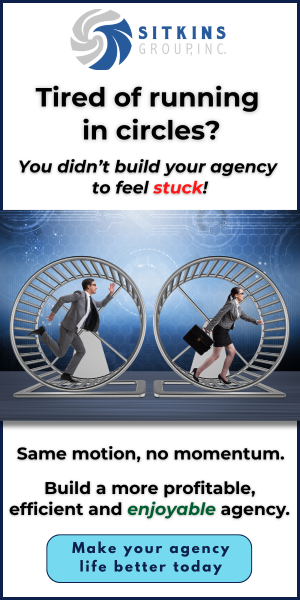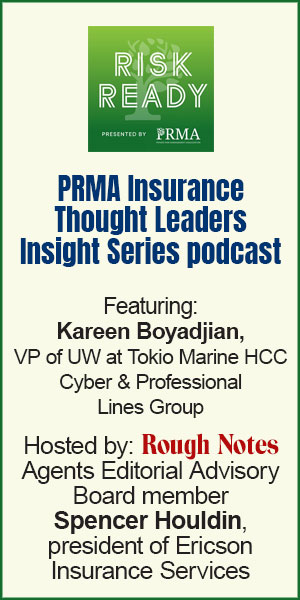Help your clients avoid problems that could suck their businesses into a storm
Risk Management
By Randy Boss, CRA, CRM, SHRM-SCP
For more than 70 years, a zone of 500,000 square miles in the Atlantic Ocean, triangulated among Puerto Rico, Florida and Bermuda, has been known as the Bermuda Triangle. This area has been linked to the mysterious disappearance of ships and aircraft dating back to 1945, when five U.S. Navy aircraft vanished without a trace. What happened is a matter of speculation, ranging from supernatural forces to human error. But no one really knows.
In business, there is a “Bermuda Triangle of Risk.” It’s triangulated among workers comp, benefits, and compliance. It can suck a business into a storm of trouble that can be tough to handle, causing countless hours of time plus money, and in some cases the loss of the business itself.
Imagine one of your client’s employees—we’ll call him Max—was just diagnosed with Parkinson’s disease and claims he fell in the parking lot at work, injuring his wrist. Max goes to his family doctor, who tells him he can’t work, so Max informs his supervisor that he is on his way to Florida, using his time off to visit his sick mother. What does your client do?
Riding out a storm in the “Bermuda Triangle of Risk” requires a strong ship with a good crew working together to avoid trouble before it occurs.
He might call his workers comp carrier, which will ask him to turn in the claim and assign an adjuster to contact him. When the adjuster calls, the client is told that the insurer will dispute the claim because the employee was already having therapy on his wrist for Parkinson’s disease. The client instructs the employee to turn in the claim to the company’s group health insurer, but when he does, he’s told the injury was work-related and the insurer is denying the claim. The client realizes Max doesn’t qualify as an “active full-time employee” because he hasn’t returned to work, so the client sends out a COBRA notice. The employee never returns to work, and his COBRA runs out. Shortly after the COBRA runs out, his spouse, who was also on the health plan, has an accident while hiking and is severely injured, with medical bills totaling over $500,000. The client informs Max and Mrs. Max that their benefits have run out. They respond that the hospital billing department mentioned something about FMLA. Oops, the client forgot to trigger FMLA because the company just went over the 50-employee limit for more than 20 weeks last year.
So who is going to pay the spouse’s $500,000 medical bill? Unfortunately, the client is. How could something as simple as a slip and fall turn into such a nightmare? One reason is silos that exist among human resources, finance and supervisors. HR might be involved with the work comp, benefits and compliance, while finance and supervisors might have information or take action that would affect the outcome without even knowing it. The reality is that once the error is made, it can be tough to control the outcome. For example, does the line supervisor know that Max communicated information to the company that triggered a potential FMLA event? We know that Max did inform his supervisor that he was using his time off to visit his sick mother in Florida. But did the supervisor know he should inform HR about the situation? Unlikely, as not many do. In fact, some might even retaliate against Max, which would just pile on more trouble. Courts have ruled that managers and supervisors can be held personally liable for FMLA violations.
Another problem is that in mid-sized companies, employees tend to wear many hats, and the focus is often on the burning issues of the day while other issues, which might affect a company down the road, get put on the back burner. For example, one person may be juggling office management, HR, compliance and accounting. What gets done first is what gets noticed first, such as making sure payroll gets out on time or the company’s year-end accounting meets a certain deadline. Compliance is often put off as something to do tomorrow. But very often, tomorrow never comes.
Riding out a storm in the “Bermuda Triangle of Risk” requires a strong ship with a good crew working together to prevent trouble before it occurs. The captain is in charge, with the first mate stepping in to steer the ship while the captain is tending to other business.
A risk advisor with knowledge of workers comp, employee benefits and compliance can be that first mate. It’s imperative to check compliance with COBRA, FMLA, ADA, HIPAA and any other labor laws that might apply. This is best accomplished by creating a compliance checklist—just like a pilot of an airplane goes through his preflight checklist before he takes off, even though he’s flown for years. Regular communication among HR, finance and supervisors is critical, as is the proper training to recognize when and how to communicate issues that arise.
Adding to the problem is the situation where one agent focuses on workers comp while another focuses on benefits, leaving HR to deal with compliance issues. As a risk professional, you can explain why it’s not a good idea to have work comp claims and benefits handled separately by different people, with no knowledge of or concern for how one might affect the other. It’s a disjointed and inefficient way to do business that can leave the business with huge gaps, often without anyone even noticing it.
Although there is no requirement for insurance advisors to go beyond selling policies, it’s important that you make your employer clients aware that the “Bermuda Triangle of Risk” exists and can be a frightening place, where a trained insurance professional can act as a bridge over these troubled waters.
The author
Randy Boss, CRM, CRA, SHRM-SCP, is a Certified Risk Architect at Ottawa Kent in Jenison, Michigan. As a Risk Architect he designs, builds and implements risk management and insurance plans for middle market companies in the areas of human resources, property/casualty and benefits. He has 39 years of experience and has been at Ottawa Kent for 34 years. He is a lead instructor for the Institute of Benefit & Wellness Advisors, training agents in how to bring risk management to benefits, and co-founder of OSHAlogs.com, an OSHA compliance and injury management platform. You can reach Randy at rboss@ottawakent.com.






